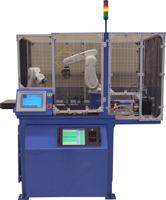Uni-Versal Test Machine
Description
Uni-Versal Test Machine, the first flexible test platform that offers totally robotic testing of metal bearings and spindles utilizing eddy current testing (ECT) for cracks, offers true automatic self-calibration. Based on Salem Design and manufacturing's vast experience in the automotive industry, the Uni-Versal Test Machine was designed to meet the current need for automated, reliable product quality verification of metal bearings and spindles—safety-critical automotive parts.
The Uni-Versal speeds up the verification process with no interruption of flow and also eliminates the possibility of operator error or misreading of results. True auto-calibration ensures consistently accurate readings. At the heart of this machine is UniWest’s US-525M multi-channel eddy current testing instrument. A rugged industrial piece of equipment, the ECT instrument offers up to eight channels, with a frequency range of 20 Hz to 10 Mz, a high signal-to-noise ratio, a bright 12-in. diagonal color LCD flat-panel screen, and data storage of 32 Gig. It offers input/output (I/O) capability, USB and Ethernet connectivity, as well as three discrete alarm gates with independent outputs per channel. The Uni-Versal has a compact footprint (37 deep x 44 in. long) and can be installed inline or alongside an existing conveyor belt.
It can be programmed to handle and test a variety of spindles and bearings. The operator simply selects the part number, a three-dimensional image of the part appears on the screen, and the Uni-Versal automatically resets the gain for that part. One robotic arm then lifts the part from the conveyer and brings it into the test machine where it is placed on a rotating chuck. Another robotic arm manipulates the eddy current probe while ensuring that it remains precisely the same distance from the part’s surface to ensure accuracy.
Separate probes robotically test inside and outside diameters for flaws. The Uni-Versal Test Machine segregates rejected parts from verified parts. An optional impact marker can then mark the accepted parts. Verified parts are then returned to the line, so there is no disruption to product flow. Rejected parts are placed onto another conveyor. Parts are divided into zones to identify flaw locations.
Specs


